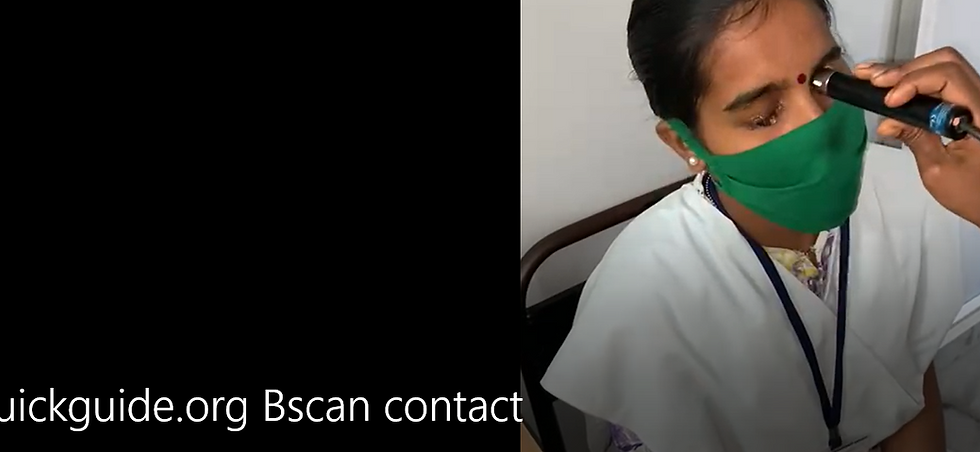Axial length measurement with Bscan
- Subhabrata Bhattacharya

- Feb 27, 2022
- 4 min read
Updated: Jan 21, 2023
Measuring the axial length of some patients with the contact/immersion ultrasound biometry or even with the optical biometry machine may be difficult. Patients with dense cataracts or conreal scar may not get a reading with optical biometry, particularly with the partial coherence interferometry (PCI) based or optical low coherence based optical biometry. Even if a reading may be obtained, it is difficult to make sure that the patient could fixate on the fixation light. Patients with very high axial length may land up with a hyperopic surprise either due to posterior staphyloma (a condition where the fovea is not located at its original anatomic position) or because of majority of optical biometry machines relying on group refractive index/ composite refractive index to calculate the axial length that may not be able to accurately measure the vitreous length ( posterior segment ) in such eyes. Some studies have pointed out that group refractive index used to convert the time taken by laser to hit the retina and reach back the device may overestimate the length of the posterior segment in such eyes thus leading to hyperopic outcomes.
On the other hand, immersion or contact ultrasound based biometry may fail to provide an accurate axial length in eyes with retinal issues like patients with retinal detachment. There may be less adequate reflection of sound beam to the probe in patients with retinal patholgy with a lot of noise (Fig 1)

In such cases a Bscan may be necessary. Bscan primarily helps to identify pathology in the posterior segment. However most Bscan machines will have an option of measuring axial length, called the A/B-scan mode.
To measure the axial length you can either measure the whole eye at one go (measuring from the corneal epithelium to the inner limiting membrane at the foveal vitreo retinal interface) or measure the vitreous lenth only and then add to the anterior segment values you have got from the immersion ultrasound. I would prefer the later because, identifying the corneal epithelium in the Bscan mode may be challenging as anatomical features of the anterior segment are not as pronounced and clearly differentiable as the posterior segment features, especially in patient's with corneal scar. However, if you are measuring the posterior segemnt length and then adding to the anterior segement length from the Ascan ultrasound machine, be sure you use the right vitreous sound velocity (1532 m/s). This is important as the phakic ultrasound settings for axial length (whole eye) is 1550 m/s and care must be taken to avoid this velocity of sound when only vitreous length is measured with the Bscan.
To start the ascan on Bscan machine activate the calipers as shown in the picture below.


While doing the Ascan measurement with the Bscan mode, the following points may be important to note:
You can do the scan by placing the probe either on the closed lid, or by the immersion technique with the patient looking at the fixation light of the probe. In Figure 3 you can see the nurse preparing for the immersion axial scan with the Bscan.

2. Gently place the Bscan probe into the fluid bath. While doing so, make sure you place the probe marker horizontally (oriented in the nasal direction) or the probe oriented vertically. In this case the probe was about to be placed horizontally in the nasal direction (figure 4)

3. Once you have achieved this probe position, you will find the Bscan displaying the corneal echoes on the left, the anterior and posterior lens echoes in the middle and the retinal echoes to the right. With the horizontal scan, where the probe marker is placed in the nasal direction, the optic nerve head ( represented as a dark shadow and marked as 'ON') is just above the center on the far right (Figure 5).

4. Locating the fovea is the next step. The foveal position is about 4-5 mm below the optic nerve.
5. Activate the markers. Bring two sets of markers (+) to the two ends of measurement. In this case, one end of the (+) should be placed on the posterior lens and the other on the vitreo retinal surface of the fovea. Note the vitreous length and add this value to the anterior segment length that you have got from the Ascan.
The measurement of axial length with the Bscan was found to be very useful in the study by Mohsen Abou-Shousha et al ( CAN J OPHTHALMOL—VOL. 51, NO. 2, APRIL 2016 ). The authors used the contact techneque wherein they placed the probe on the closed eye lid aligned to the patient's visual axis ( Figure 2 shows the contact technique wherein probe is placed on the lid). However, irrespective of contact or immersion method, the location of the fovea would not differ (as described earlier) as long as the probe is kept horizontally and the probe marker placed in the nasal direction.
In conclusion and in my experience, the use of Bscan for axial length calculation is largely missed in most places. Patients with retinal detachment, posterior staphyloma, or high myopia could still get a near accurate axial length reading, if Bscan machine is used for the axial length measurement. Among its many advantages, the ability of the operator to visualize the posterior segment and then accordingly orient the probe, or take the measurement by adjusting the patient eye position may help in getting an accurate reading in challenging eyes. In cases of retinal detachment, the operator can re orient the marker and move it to the vitreo retinal base to correctly measure the length of the eye.





